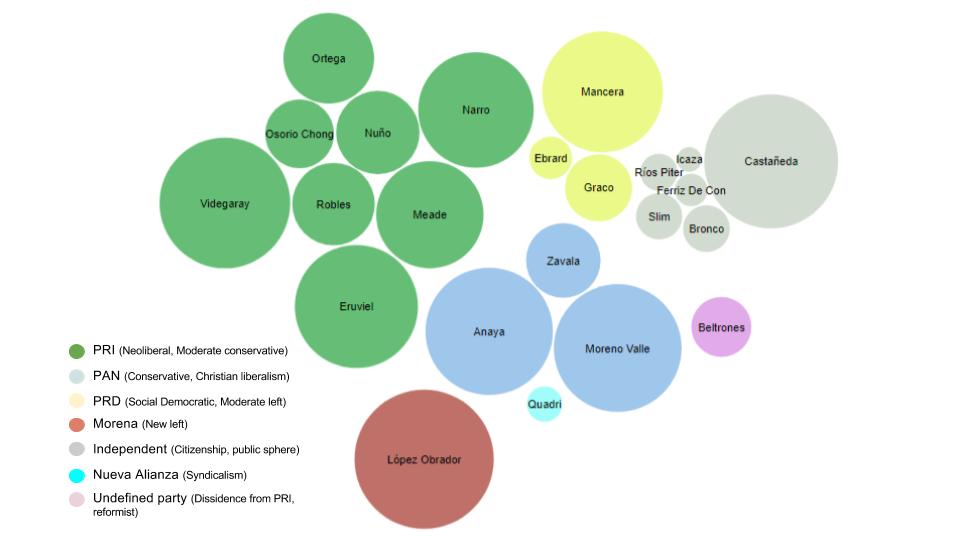Facebook Pages in Mexican Presidential Pre-campaigns
Facebook as a digital ecosystem of misinformation in upcoming Mexican presidential pre-campaigns 2017-2018Team Members
Enedina Ortega Gutiérrez and Eloy Caloca Lafont. Tecnológico de Monterrey, Mexico City Campus.Special thanks
This project had not been possible without the guidance, support, knowledge and suggestions of Richard Rogers, Paola Ricaurte Quijano, Open Labs, María Elena Meneses, Gabriela Sued, Emilja Jokubauskaite and Guillén Torres Sepúlveda.Contents
Summary of Key Findings
- There are 23 people, mostly politicians, public servants, journalists and activists, who have declared to traditional and Internet media they want to run on 2018 presidential election. From all these, the top five according to their presence on digital media (Google News) are Andrés Manuel López Obrador (Morena party), Ricardo Anaya (PAN), Jorge Castañeda (independent), Luis Videgaray (PRI) and Miguel Ángel Mancera (PRD).
- Not all the most popular candidates on Google News are the ones with the most relevant presence on Facebook. The aspirants with the largest number of open and active Facebook pages are Andrés Manuel López Obrador (Morena), Margarita Zavala (PAN), Miguel Ángel Mancera (PRD), Miguel Ángel Osorio Chong (PRI) and Jaime Rodríguez (independent).
- There are two kind of Facebook pages per candidate according to their type: official and unofficial. Official pages are the ones managed by political parties, supportive media or citizen organizations, while unofficial ones are anonymous. Official pages have lot more followers than the unofficial ones, and for all the candidates considered, their number of official pages is higher than the quantity of unofficial ones. López Obrador shows a balance between official (52.7%) and unofficial pages (47.3%), but other candidates have no significant unofficial spaces.
- Official pages have a larger amount of followers because they spread massively quicker, both using traditional viralization (from Facebook profile to profile) and Facebook paid services (widespreading through the company's metadata).
- 81% of Facebook pages related to Andrés Manuel López Obrador stand in pro of him, while 19% are offensive pages against him. In the case of other candidates, most of the pages associated with them are supportive, while offensive contents are just a few. This may show Facebook is more popular to support a candidate rather than to oppose him.
- According to their function, supportive pages can either be “informative” or “praising”, and opposer pages, “offensive” or “trolling”. There are some pages opened just to “redirect” to other pages and get more followers for them. Also, there are “clone” pages that copy most of their contents from other pages. López Obrador is the candidate with the highest number of pages of all type, while Margarita Zavala has more supportive than offensive pages. The same happens with Mancera, who has no relevant offenders, and Jaime Rodríguez, who has no offenders at all. Osorio Chong has only a few unpopular supportive and offensive pages.
- The profile of each candidate's followers is closely related to their ideology and the tendency and function of their Facebook pages. López Obrador, for example, is mostly followed by leftist intellectuals, politicians, journalists and Internet media, while Margarita Zavala´s followers are conservative associations. The followers of Miguel Ángel Mancera are Mexico city's private and public institutions, the ones of Osorio Chong come from the PRI, and the ones of Jaime Rodríguez are located in Nuevo León.
- The most engaging posts of each candidate are related to ideological radicalism and strong emotional contents. López Obrador can be either portrayed as “a hope” and “a change”, or as “an authoritarian” and “a danger for Mexico”; Margarita Zavala can be either a “kind family woman” or “an assassin”; Mancera, a “political solution” or “an incompetent”; Osorio Chong, a “statesman” or a “murdered”; and Jaime Rodríguez is always shown as a popular “cowboy” committed to the poor.
1. Introduction
The upcoming 2018 Mexican presidential election is still uncertain. In the last two electoral processes, during 2006 and 2012, Mexican citizenship chose the conservative party Acción Nacional (PAN) and the moderate conservative and in the last three decades neo-liberal Partido Revolucionario Institucional (PRI) respectively. However, the results of the two last elections were extremely hard-fought considering the candidate of the progressive left Andrés Manuel López Obrador, who contended representing the Partido de la Revolución Democrática (PRD) in 2006 and for Movimiento de Regeneración Nacional (Morena) in 2012 lost only for 0.6% of the total vote count twelve years ago and for 5.2% during the last counting (Pedraza, 2006; Covarrubias, 2012). The narrow margins that led López Obrador to lose on past years caused speculation about possible illegalities, electoral frauds or dirty campaigns coming from the winner parties (Poy, 2012), nevertheless, there were no pertinent clarifications about these procedures before the judicial organs of the Mexican administration. What did happened was a political and ideological division between the Mexican citizens marked by hermeticism in the dialogue and radicalization of postures, going from the absolute support to total hate towards a candidate.
On the next year´s electoral process Andrés Manuel López Obrador will be running again for president. Although the profiles and names of other candidates remain unknown it is logical that the atmosphere of radicalism and anger would prevail, especially considering the latest scandals of millionaire robbery from local governors in the states of Veracruz or Sonora coming from the PRI and the PAN (Belin, 2015), or a recent polemical election in Estado de México where, while Morena accused the PRI of electoral fraud, its counterpart denounced lack of transparency in the way the left party obtained the funds for its campaign (Milenio Digital, 2017). In this climate of political instability the strategic role of Facebook fan-pages still needs to be studied closely. Facebook has been a tool for the supporters or detractors of the candidates to disseminate news, contents and messages to enforce or discredit a certain figure or party through both closed and public, official or unofficial accounts. In this exploratory project we looked how Facebook fan-pages have been used during the last months to filter supportive or revile discourses around those candidates close to the presidency and how would these affect the next elections. Also, we tried to find the relationships between the technical functions and behaviors of the Facebook platform and fan-pages with the political tendencies and phenomena that can be identified in the Mexican electoral culture.2. Initial Data Sets
2.1. Most popular presidential pre-candidatesThe first dataset we used was a small list of those public figures that according to recent news (only considering 2017 Internet media) have proclaimed their intentions of becoming the president of Mexico or declared openly their nomination associated to a party or as independent candidates. Using Google News results we got 23 people associated with the PAN, PRI, PRD or with Morena, linked with smaller parties as Nueva Alianza, or not associated with a party at all. As a second dataset we looked how many times did every one of these 23 people appear on Google News registering their rate of results. The most important five figures according to the media were the ones we considered to work with. Later, we scraped all Facebook fan-pages related to each candidate using the digital tool Netvizz (Rieder, 2013). As according to Facebook API Netvizz has no longer access to private or personal accounts, we only considered open and public fan-pages, defined as profiles specifically created for bussiness, brands, celebrities, organizations or, in this case, ideological causes, political movements or presidential candidates (Rouse, 2017).
2.2. Facebook fan-pages datasetWe built five main datasets, one per pre-candidate, listing all Facebook pages linked with each one, considering: 1) the candidate´s official fan-page(s); 2) all official supportive pages (partisan groups, citizenship organizations, propagandistic media); 3) all unofficial supportive pages (any digital space managed by anyone, without direct affiliation); and 4) all unofficial revile pages. Totally, we got 2131 pages summing the five candidates.
2.3. Most engaging posts dataset Finally, using the 10 most rated Facebook pages per candidate (the ones with the highest number of “likes” or followers), we got a new dataset of all the latest posts per page using Netvizz. In total, we extracted the last 500 posts in each case, or all posts from january 2017 up to july 2017. After building all datasets, one per page, we ordered the posts using their engagement rate (an average of “likes”, “shares” and “comments”) to find the top 5 most engaging posts.3. Research questions
- What will be the role of Facebook pages in the upcoming Mexican presidential elections 2018?
- What has been the role of those same pages on the actual running pre-campaign?
- How do Facebook pages function in relation to a political environment? Are they mostly official or unofficial? Pro or against to whom?
- How do these pages use their contents to improve or harm the image of a candidate?
- What kind of contents are presented in each candidate´s Facebook pages? Which of them are the most engaging?
4. Methodology
We used a mixed approach taking both quantitative or distant reading and qualitative or close reading perspectives (Moretti, 2013). Our research was divided using the following activities:
4.1. Query design: Scraping the five most popular pre-candidates and all their Facebook pagesWe did an exploratory search on Google with the words “presidential candidate(s)” and “Mexican elections 2018” to get the names of those people who intend to run in the next electoral process. Also, we did the same search on Google News. We got 23 aspirants, from which we chose the five with the highest number of mentions on Internet media. After getting this small list we used the Netvizz app to find how many Facebook pages can be found related to each candidate and scrap their names, descriptions, Facebook IDs and URLs from the Facebook database. One preliminar discovery we obtained was that there were a very few pages linked to the candidate's full name, so we made a list of all the possible short names, nicknames or initials used in the media and the popular culture to identify each candidate. This way we got a more complete dataset of all Facebook pages per public figure.
4.2. Building, merging and cleaning each one of the datasets per candidateNetvizz scraps all the Facebook pages related to a certain search and groups all their metadata in a CSV (comma-separated values) table. However, as we got different CSV files per candidate associated with their different short names, nicks and initials, we had to build a new dataset for each one of the candidates:
- First, we merged all the CSV tables per candidate together using a Google spreadsheet.
- Later, we ordered all the results in this new dataset, going from the ones with the highest number of “likes” or followers to the least rated. There were some Facebook pages with less than 500 followers. Considering these pages were not relevant nor representative for the electoral discussion in Mexico we took them away.
- Finally, we discarded also all those pages that were repeated in the dataset. Some of them linked their metadata to both the full name and a nick name of a candidate, so we got them two or more times in the final dataset and had to clean them.
After having five large datasets, one per candidate, we categorized the listed Facebook pages, one by one, using the following criteria:
- Type: Official or unofficial pages.
- Tendency: Pro or against (the candidate or party).
- Function: (If the page was opened to) inform, praise, revile, redirect (to another page), clone (copy exactly the contents of another page with different metadata) or troll (post offensive contents, mostly related with sexism and vulgarity).
After building and categorizing the candidates´ datasets we analyzed them using several strategies:
- We used RawGraphs to visualize the rating of total followers per type of Facebook page, tendency and function.
- Using network analysis, Netvizz and a Gephi graph we discovered which Facebook pages were the top “likers” of followers per candidate. For this, we only made a graph of the top official-supportive, unofficial-supportive and unofficial-revile pages. In the case of López Obrador, the only candidate with “trolling” pages, we applied also a network analysis to the most relevant of these Facebook spaces.
We used the Facebook IDs of the most rated official-supportive pages, unofficial-supportive pages and unofficial-revile pages to extract the last 500 posts in each one (or to get all of their posts, if the contents were less than 500). After getting this dataset, we detected the most engaging posts or those ones with the highest engagement rate (an average of total “likes”, “shares” and “comments”), in order to detect the main topics or agendas of each candidate.
5. Findings
5.1. Aspirants to be candidates in 2018 per party and ideologyThe 23 most relevant public figures who are looking to become the president of Mexico in 2018 according to Google News results are:
- For the PRI, the current minister of foreign affairs Luis Videgaray, the minister of government Miguel Ángel Osorio Chong, the minister of education Aurelio Nuño, the minister of public finances José Antonio Meade, the minister of agricultural management Rosario Robles, the ex-director of the National University of Mexico (UNAM) José Narro, the ex-governor of the state of Yucatán Ivonne Ortega, and the ex-governor of Estado de México Eruviel Ávila.
- For the PAN, we found the ex-first lady Margarita Zavala, wife of Mexican last president Felipe Calderón, the senator Ricardo Anaya, who is also the president of the party, and the former governor of the state of Puebla Rafael Moreno Valle.
- For the PRD, the aspirants are the mayor of Mexico City Miguel Ángel Mancera, the ex-mayor of the same city Marcelo Ebrard, and the governor of the state of Morelos Graco Ramírez.
- For the small party Nueva Alianza, the intellectual and ex-syndical leader Gabriel Quadri.
- For an undefined party, the dissident from the PRI, senator and ex-president of the Mexican Senate Manlio Fabio Beltrones.
- To run as independent candidates (without party), the ex-minister of foreign affairs Jorge Castañeda, the ex-coordinator of the Institute of Housing of Mexico (INFONAVIT) Armando Ríos Piter, the journalist Pedro Ferríz De Con, the human rights defender Emilio Álvarez Icaza, the current governor of the state of Nuevo León Jaime Rodríguez Calderón, known as “El Bronco” and the worldwide known millionaire Carlos Slim.
- And finally, as the only candidate for Morena, Andrés Manuel López Obrador, known by his opposers as “El Peje” or “El pejelagarto” (freshwater gator).
After scraping in Netvizz all the Facebook pages per candidate we discovered the PRI aspirant Luis Videgaray has no other page than his official site, and the same situation happens with other PRI aspirants as Narro, Ortega, Eruviel Ávila and Meade. Also, this happened with the independent aspirant Jorge Castañeda. To replace these candidates with the next ones in importance, we chose Miguel Ángel Osorio Chong for the PRI, who has 49.4 million results in Google News, and Castañeda with Jaime Rodríguez Calderón El Bronco, whose total results on Google News are 24 million. We also replaced the aspirants of the PAN Ricardo Anaya and Rafael Moreno Valle with Margarita Zavala, because while Anaya has only 3 Facebook pages and Moreno Valle has 2, Zavala´s number of pages is higher. The total number of Facebook pages per candidate obtained by Netvizz were:
- 74 associated with Andrés Manuel López Obrador or his other names (López Obrador, AMLO, El Peje, El Pejelagarto). In this counting we also considered some compounded-word jokes such as the supportive AMLove (AMLO + love) or Pejistas (“team Peje”), and also de revile adjectives Anti-AMLO, Anti-Peje.
- 22 related to Margarita Zavala, taking into account both positive names as Margarita and La Zavala, and negative nicknames as La Calderona (given for her marriage to Felipe Calderón) and La Chimoltrufia (given for her supposed similarity to a Mexican television character portrayed by comedian Florinda Meza).
- 7 associated with Miguel Ángel Mancera or the search Mancera.
- 8 in relation to Miguel Ángel Osorio Chong, merging other searches like Chong or Osorio Chong.
- And finally 5 related to Jaime Rodríguez or his nickname El Bronco.
- 7,273,859 in the case of Andrés Manuel López Obrador.
- 1,048,910 for Margarita Zavala.
- 881,152 in the pages of Miguel Ángel Mancera.
- 174,434 for Miguel Ángel Osorio Chong.
- And 27,120 for Jaime Roríguez El Bronco.
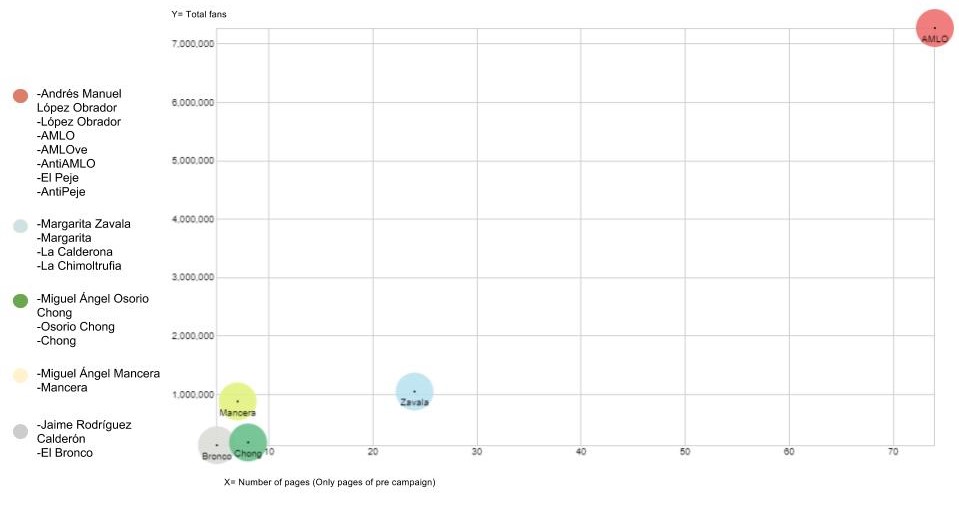
- Andrés Manuel López Obrador has 39 official pages (52.7%) and 35 unofficial (47.3%). All the official ones support the candidate, while from the unofficial pages, 6 are in pro and 29 against. In total, López Obrador has 45 supporter pages with 5,890,869 followers (81%) and 29 pages against him with 1,382,990 opposers (19%).
- Margarita Zavala has 16 pages that are both official and supportive with 972,850 followers (92%), 4 pages unofficial and supportive with 75,963 followers (7.2%), and only 2 pages against her, both unofficial, with 97 opposers in total (just 0.8%).
- Miguel Ángel Mancera has 5 official pages that support him with 880,776 followers (99.9%), one unofficial supportive page with 207 followers (.033%), and only one page against him with 169 opposers (.013%).
- Miguel Ángel Osorio Chong has 4 pages that are both official and supportive with 174,006 followers (99.5%) and 4 unpopular, unofficial pages against him with only 428 opposers (0.5%).
- Finally, Jaime Rodríguez El Bronco has 2 official pages that support him with 25,312 followers (97.1%) and 3 unofficial supportive pages with 3662 followers (2.9%).
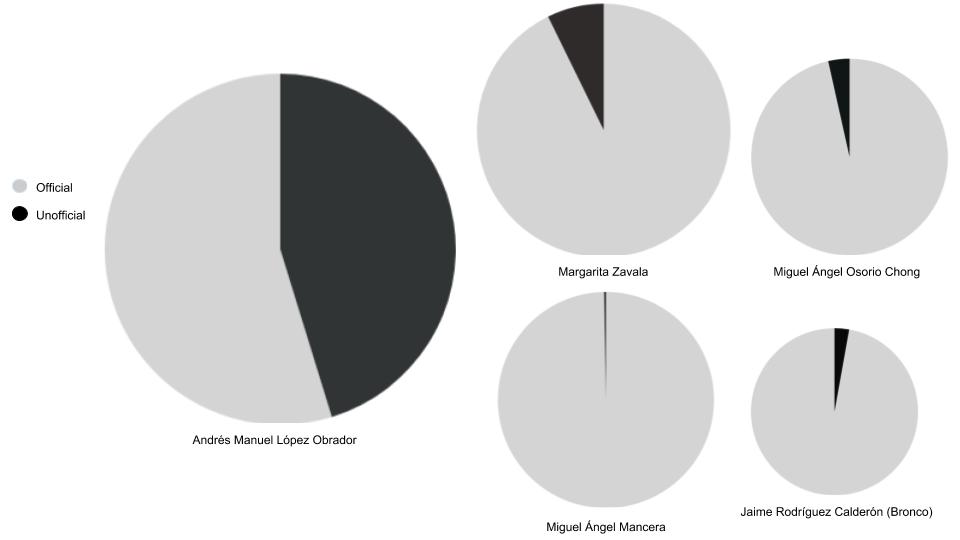
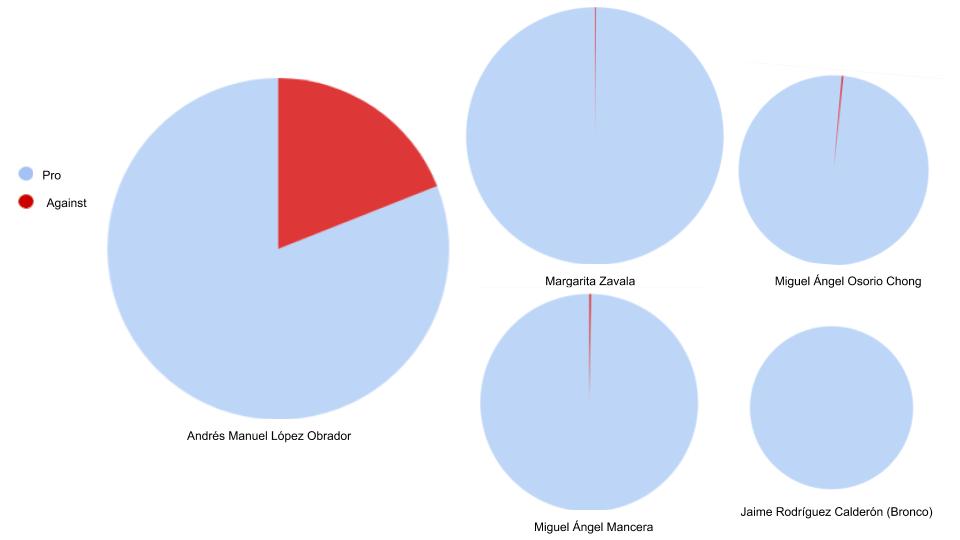
- In the case of Andrés Manuel López Obrador, official pro or supportive pages can be classified into: 4 informative pages (the largest is López Obrador´s official fanpage managed by the politician´s pre-campaign team, with 2,073,720 followers) and 35 pages to “praise” or point out the qualities of the candidate (from which the largest is Red Nacional de Jóvenes por López Obrador, a supportive youth organization, with 43,864 followers). 3 pages of these 35 “praising” ones were created only to “redirect” or link to the candidate´s official fan-page, so we may consider only 32 of them are genuine. From all his unofficial pages we found 6 pages that support the candidate, from which there are 2 informative unofficial media (the largest one, Radio AMLO with 525,832 followers) and 4 to “praise” the candidate (the largest one, AMLO Presidente de México with 23,590 followers); on the other hand, there are 29 unofficial pages against López Obrador, from which 25 were created to offend or “revile” the candidate with humourous hate (the largest is Las aventuras de López Obrador, that portrays the candidate as foolish and cartoonish), 1 of them is a “clone page” that copies all its contents from the largest “revile” page, called almost the same (Las aventuras del Peje), and 3 of them are used to “troll” or offend the candidate with extreme aggression and absurdity (the largest one is Andrés Manuel López Obrador fake-page with 30,690 followers). In total numbers López Obrador has 4 informative pages, 35 “praising” ones (3 of these “redirect” to his official fanpage), 1 offensive “clone-page”, 25 pages to “revile” him and 3 “trolls”. Nevertheless, to know how many people support, hate or troll López Obrador for real the number and distribution of pages is not enough. Considering the number of followers per category we realized there is a different distribution. He has 2,750,285 people who “inform” about him, 227,732 “praising” him on Facebook and 867,782 haters. We also may consider 59,746 people as supporters that gave a “like” to one of the pro redirecting pages, 3723 people as haters that “like” the clone-against page, and 76,997 people that “like” the “troll” pages. Totally, it is possible to say López Obrador has 3,037,763 people that support him on Facebook, but only 227,732 “lovers” or people openly “praising” him. On the other side, he has a total of 948,502 declared haters or trolls.
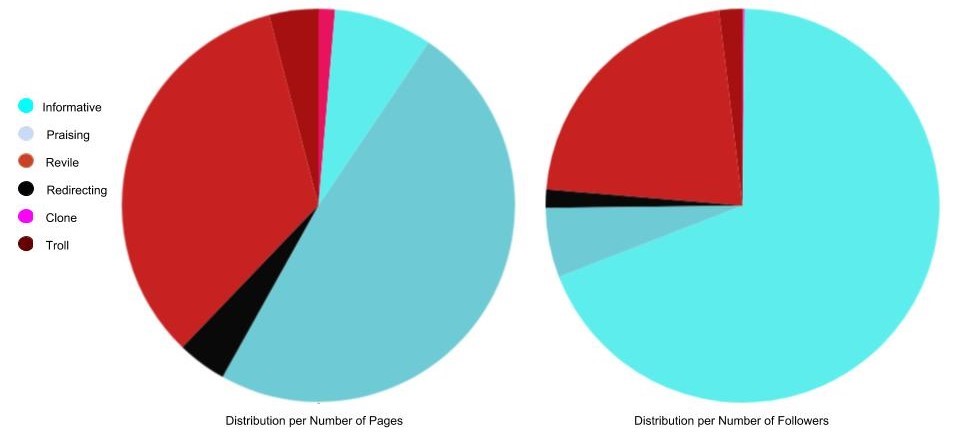
- Margarita Zavala has 20 supportive pages on Facebook (16 official and 4 unofficial), from which 2 of them are “informative” (the largest one is the official fan-page of the candidate, Margarita Zavala, with 533,238 followers), while the other 18 were opened to “praise” her (the largest page of these, from the official ones, is Margarita Zavala Presidenta with 138,893 fans, and from the largest unofficial one, Apoyo a Margarita Zavala para el 2018 with 35,431 fans). Zavala has only 2 pages against her and both of them were created to “revile” or offend her: Margarita Zavala La Chimoltrufia and No a la reelección de Felipe Calderón y Margarita Zavala. She has no pages redirecting other ones, cloning contents or “trolling” her. As in the case of López Obrador, the distribution of pages is different than the distribution of followers: 675,076 supporters want to get “informed” about her in Facebook and 297,705 openly “praise” her, but there are only 97 people that hate her on this social media.
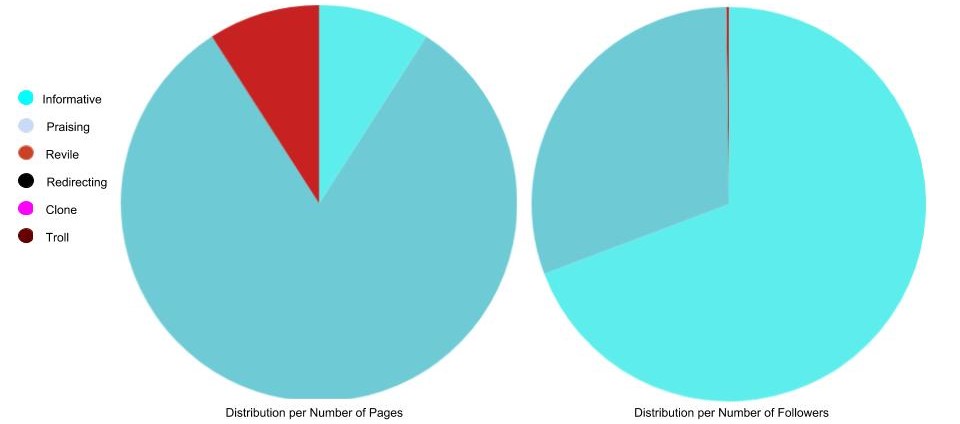
- Miguel Ángel Mancera has only 1 informative page (the official one of the candidate, Miguel Ángel Mancera Oficial with 935, 747 fans), 4 more official pages “praising” him with a very few followers (the largest one, Miguel Ángel Mancera has 252 fans), 1 unofficial “praising” page (called Miguel Ángel Mancera Espinosa), and 1 unofficial “revile” page (Fuera Miguel Ángel Mancera with 169 fans). Comparing the high rate of fans (almost 936 thousand) in his official-informative space to his unofficial supporters (3246) and haters (169), it is not necessary to show in a graph that almost 100% of his followers belong to his official page and that he has not a relevant number of opposers on Facebook.
- Miguel Ángel Osorio Chong has, as Mancera, 1 informative page (the official one, Miguel Ángel Osorio Chong, with 173,321 fans), 3 more official pages “praising” him with no relevant number of fans (897 in total, 99% of them coming from the page Miguel Ángel Osorio Chong while only 90 in Club de Fans Lic. Miguel Ángel Osorio Chong), and finally 428 haters in 4 unofficial “revile” pages (the most offensive and relevant are Osorio Chong with 231 fans and Chinga Tu Madre Osorio Chong with 213 fans). Again, there is no need of a graph, because almost 99% of his followers belong to the official-informative page.
- Jaime Rodríguez Calderón has only supportive pages. From his 2 official Facebook pages, 1 is informative (El Bronco with 21,650 fans). The remaining 4 pages were created unofficially to “praise” him (the largest one is Nuevo León con Jaime Rodríguez with 1210 fans). Another time, the great majority of followers of the candidate belong to the informative space (85%).
- In the case of López Obrador, the most important followers of his official informative page, named just like him, Andrés Manuel López Obrador, are: 1) Regeneración, an open journal of resistance and new left thinking popular in Mexico, 2) Revolución 3.0, a community of blogs and an open journal that oppose to the actual Mexican government of the PRI, and 3) Radio AMLO, the largest unofficial informative page.
- If we consider López Obrador´s largest unofficial informative page, Radio AMLO, we will find as main followers: 1) the page of the broadcaster YouTube, 2) Regeneración another time, 3) the mexican magazine Proceso, 4) the newspaper La Jornada, 5) the candidate´s official page, 6) the french socialist politician Jean-Luc Melenchon, 7) the American intellectual Noam Chomsky, 8) the environmental organization Greenpeace, 9) the official page of the cultural program of Mexican National University, Cultura UNAM, and 10) the cultural tv channel Canal 22.
- Following his largest official praising page, Red Nacional de Jóvenes por Andrés Manuel López Obrador are: 1) Regeneración, again, 2) the official informative page, Andrés Manuel López Obrador, 3) La Mano Sucia de Chevron, a protest collective, and also, 4) the politician Martí Batres, who wants to be the mayor of Mexico City running for Morena, and 5) Alejandro Encinas, actual presidente of the Mexican Senate and open supporter of Morena.
- Considering López Obrador´s largest unofficial praising page, AMLO Presidente de México, the main followers are: 1) the Facebook site of the Mexican journalist Carmen Aristegui, 2) Regeneración, 3) La Jornada, and 4) López Obrador official site.
- Taking the largest unofficial revile page, Las aventuras de Andrés Manuel López Obrador, there are only 2 Facebook pages as followers: Las aventuras de Carlos Salinas, a humoristic gag page praising neoliberalism and Mexican ex-president Salinas, and the page No al fanatismo de izquierda, created to protest against the extreme left parties and movements.
- Finally, an analysis of a trolling page to ridicule López Obrador only revealed one Facebook public page linked: the revile space Las aventuras de Andrés Manuel López Obrador.
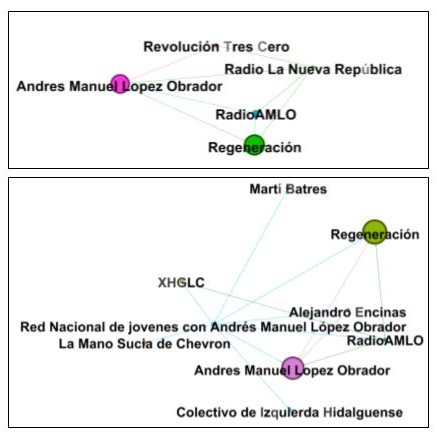
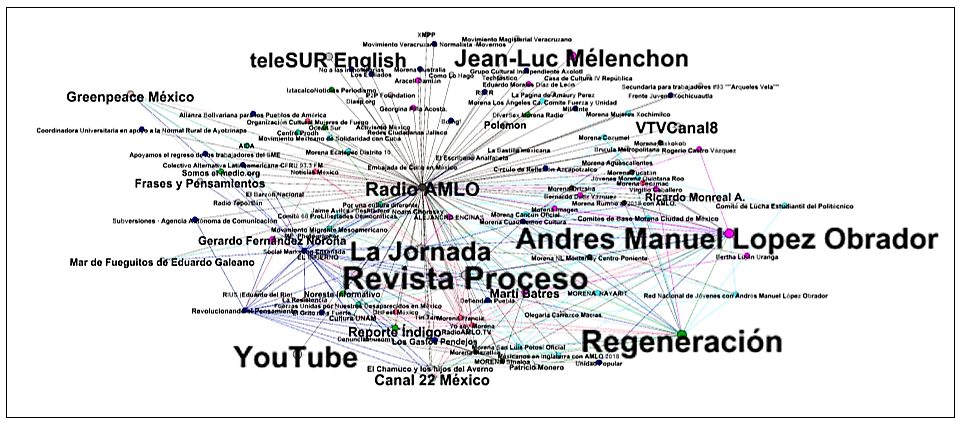
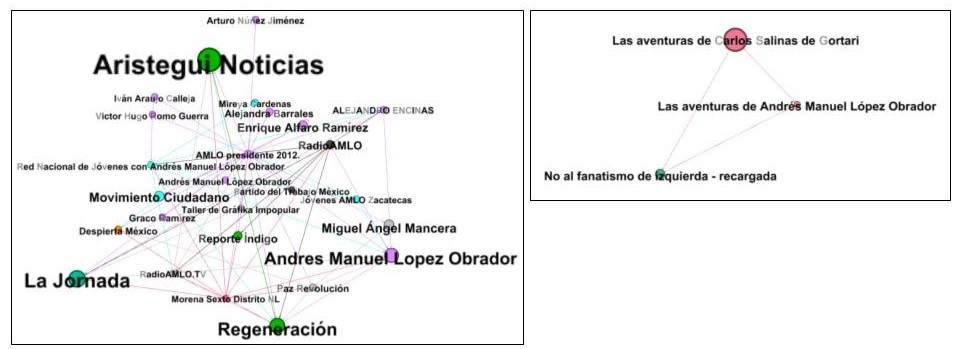
- In her official informative fanpage, Margarita Zavala, the main followers are: 1) her husband and Mexican ex-president Felipe Calderón, 2) the citizenship association Yo con México (funded by the Calderón marriage), and 3) a committee of Mexican students from the Washington University.
- In her main official praising page Margarita Zavala Presidenta, the only relevant follower is her own Facebook fanpage.
- In her largest unofficial praising page, Apoyo a Margarita Zavala 2018, her main followers are: 1) her own Facebook fanpage, again, 2) Margarita Zavala Mujeres (the female faction of Zavala supporters), and 3) Margarita CDMX (the supporter campaign base at Mexico City).
- And finally, in her largest unofficial revile page, Margarita Zavala La Chimoltrufia, there is only one important follower: Regeneración, a journal that is one of the top supporters of López Obrador.

- In his official Facebook fan-page, Miguel Ángel Mancera has the Government of Mexico City page as main follower, as well as the United States Embassy in Mexico, international summits and events as World Design Capital 2018 and C40 Cities, and cultural public spaces as the national park Bosque de Chapultepec and the art museum Museo de Arte Popular.
- In his main official praising page, called as well Miguel Ángel Mancera, he has only one important follower, his own official Facebook fan-page.
- In his top unofficial praising page, Miguel Ángel Mancera Espinosa, there is only one outstanding follower, the Government of Mexico City.
- And finally, in his main opposing page, the unofficial revile Fuera Miguel Ángel Mancera, his top followers are: Trabajo Social, Ampárate legalmente and Mancera Enlace. The first two have very few followers on Facebook (0 or 5), so they may be fake accounts using bots, while Mancera Enlace is the page of the mayor of Mexico City to contact the citizens, which could reached this revile page due to automatic activities (following all contents related to Mancera).

- In his official Facebook fan-page, called Miguel Ángel Osorio Chong, he has only one relevant follower, Alerta Amber, a governmental initiative for helping the families of missing or deceased people due to Mexican violence.
- In his top unofficial praising page, Chong has only one important follower too, his own official Facebook fan-page.
- Finally, on his most popular unofficial revile page, Osorio Chong has only two significant followers, Baches de México, a protesting page against the government, and Supercívicos, a collective to denounce government mistakes on media.
- In his official Facebook fan-page, named Jaime Rodríguez Calderón, the most important followers are two web newspapers, Progreso Hoy and Informa NL. He is also followed by a large restaurant, Las Comadres, by small supportive fan-pages (Fuerza Regia, Broncomanía, Broncos NL), and institutions like the United States Consulate in Nuevo León and the local Justice Council (PGR NL).
- In his top unofficial praising page, Nuevo León con Jaime Rodríguez, the only relevant follower is a commercial center in Monterrey named Zitla.
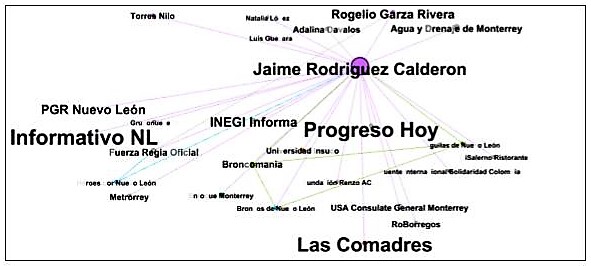
- A post with photo in his Facebook official fan-page about a recent reunion of the candidate with the Mexican writer and senator Laura Esquivel, who is also a popular intellectual for her novel “Como agua para chocolate” and a relevant academic, indigenist and feminist in Mexico.
- A family photo and message from the candidate to all his followers in the official praising page AMLO Movimiento Morena (and also posted on his official fan-page and Red Nacional de Jóvenes con Andrés Manuel López Obrador) where he says: “This times must be quite important for all christians, because as Jesus is a symbol of love and justice, we desire you all, friends of Facebook, true happiness. Specially, this message goes to those that suffer. We will stand with you all”.
- A photo of a visit of the candidate to the indigenous community of Matlapa, in the state of San Luis Potosí, posted in the unofficial praising page AMLO org (and also shared by many others like AMLO Esperanza de México, Siguiendo a AMLO, AMLO Movimiento Morena, etcetera) with the message: “Look the monstrosity and inequality in Mexico with fifty thousand rich people and millions in poverty. (...) We need to moderate the richness and the poverty to reach equality”.
- A revile post from the opposition page No se apendeje no vote por El Peje (Don´t be a fool, don't vote for Peje) with the message “El Peje wants to make of Mexico another Venezuela”, and a photo of López Obrador in resemblance to Hugo Chávez.
- A revile post from the page AMLO NO with a video where López Obrador says the energetic situation of Mexico is accurate, and the message “Why is López Obrador incompetent? Look what he says about the oil”.
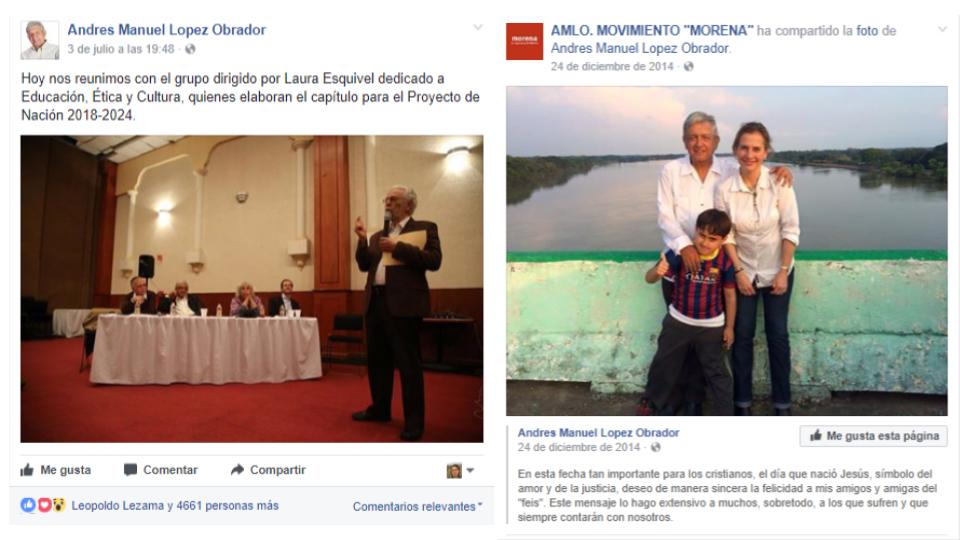
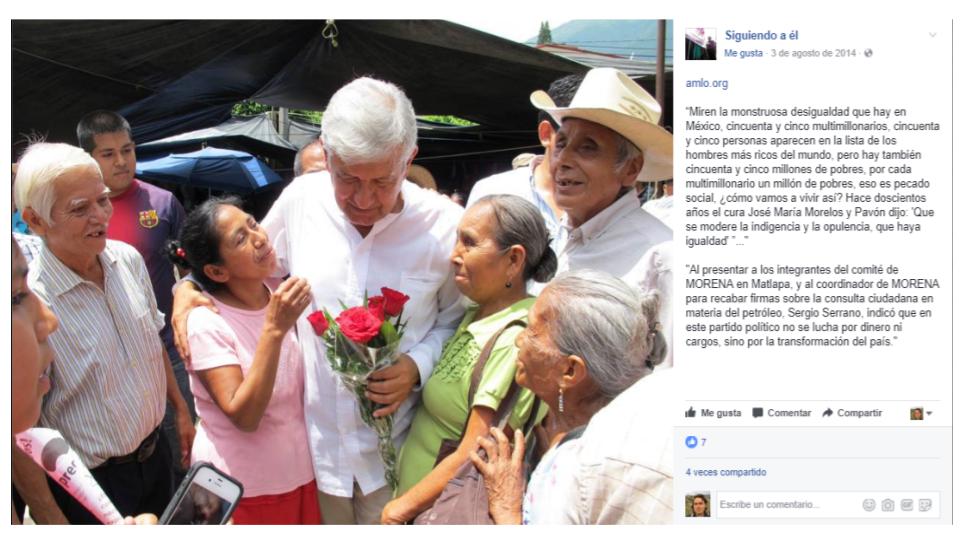
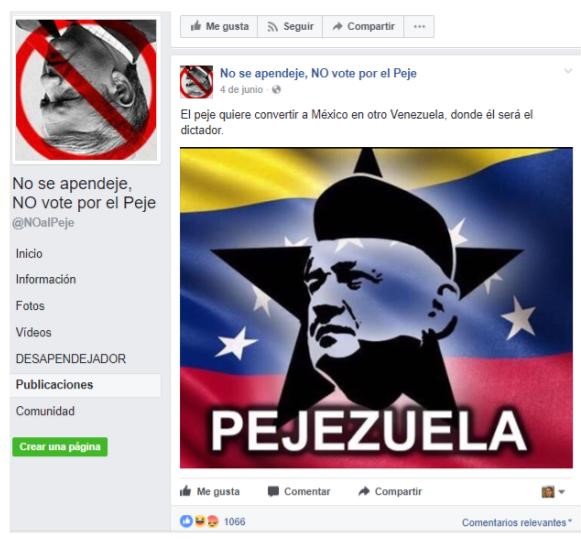
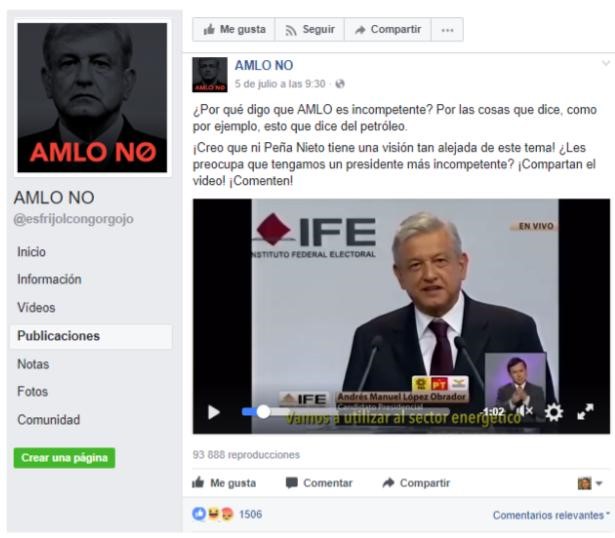
- A post from her official fan-page with the message “In Mexico we say no to populism” and a photo of Zavala giving a public speech surrounded by a Mexican flag.
- A photo album from her official praising page Yo con México portraying her visit to the largest mexican urban marketplace and the message: “The Central Market (Central de Abasto) is very important to all its producers. We are going to recover its infrastructure and security”.
- A photo from her unofficial praising page Margarita Zavala 2018 showing her hugging her family (ex-president Felipe Calderón and her two children) outside the Mexican government palace.
- A photo from her unofficial revile page No Relección a los Calderón with the message “No Reelección por la paz de México” (Not a reelection for Mexican peace). The image, edited by photo-montage, portrays Margarita Zavala and his husband Felipe Calderón with their hands stained with blood.
- A meme from her unofficial revile page Margarita La Chimoltrufia showing Zavala with the message: “La Calderona is actually a danger for Mexico because she concealed 120 thousand dead during her husband government and a millionaire robbery to Mexican oil deposits. Share if you agree”.
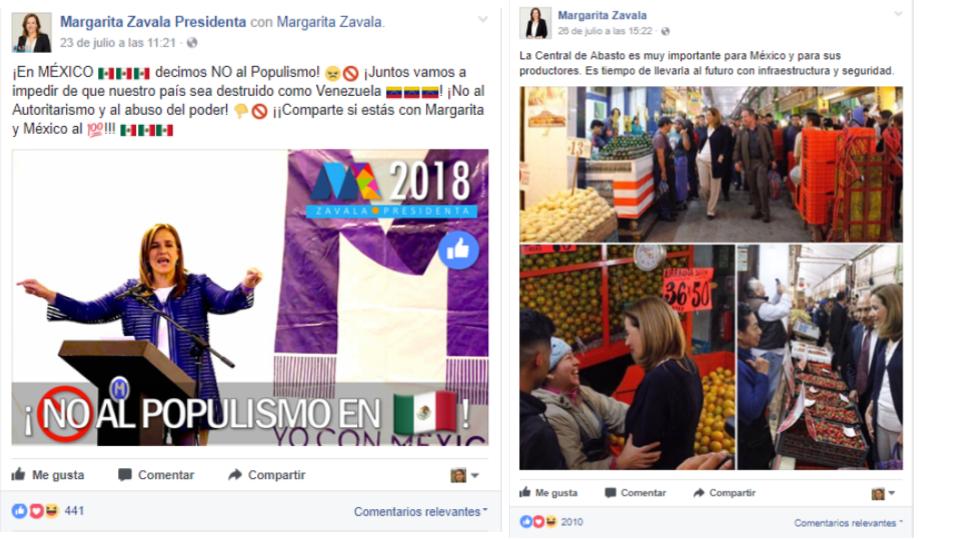
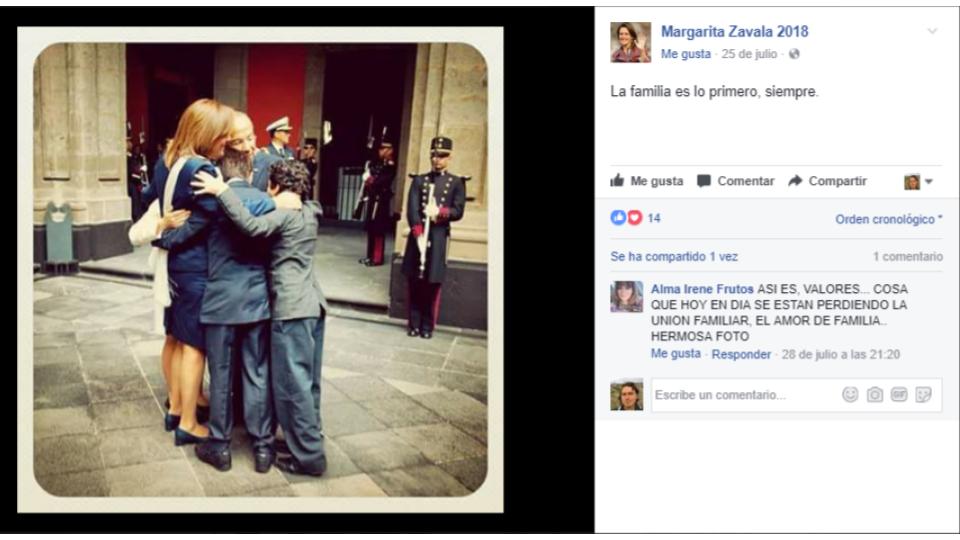
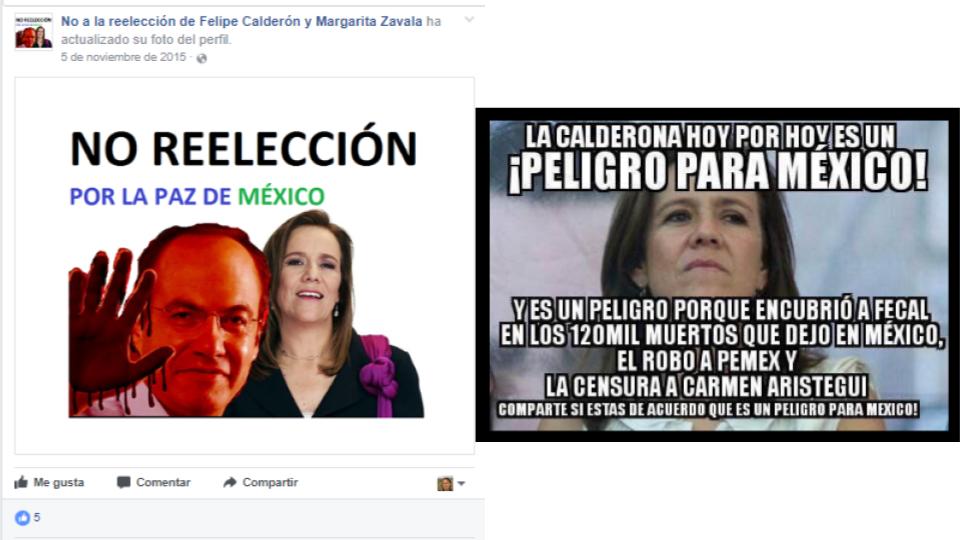
- A photo album in his official Facebook fan-page of a public gay pride event with the message “We impulse respect, peace and diversity”.
- A photo album in his main unofficial praising page, Yo apoyo a Miguel Ángel Mancera, with diverse images of public events and the message: “In 2018 will come a new citizenship project where leaders of the left will work all together, said Miguel Ángel Mancera in the inauguration day of Javier Coral as justice minister of Chihuahua”.
- A photo from the largest unofficial revile page Fuera Miguel Ángel Mancera with the message: “Mancera out, this is serious. Say no to the Stop Circulation Plan. Mancera out”. The Stop Circulation Plan in Mexico City was the proposal of Miguel Ángel Mancera of forbidding one or two circulation days per week to all personal automoviles to reduce pollution.
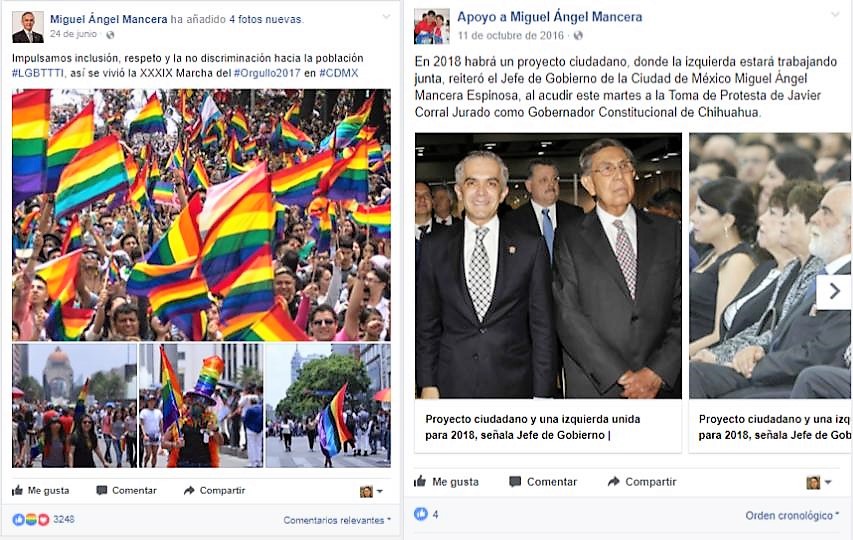
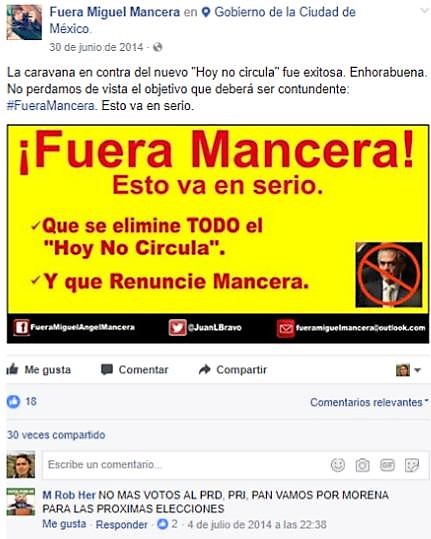
- A photo album on his official Facebook fan-page portraying him in public events with citizens and a message saying: “The co-working between government and society brings excellent results”.
- A photo of his unofficial praising page Club de fans de Miguel Ángel Osorio Chong portraying the candidate aside the current Mexican president Enrique Peña Nieto in a solemn judgement day with members of the army, inside Mexican presidential palace.
- A photo of the unofficial revile page Chinga tu madre Osorio Chong with the message: “Osorio Chong is a murderer. He shot the people in Oaxaca”. The massacre referred here was a terrible repression from the federal army against a syndicalists and teachers´ protest in Oaxaca on 2015.
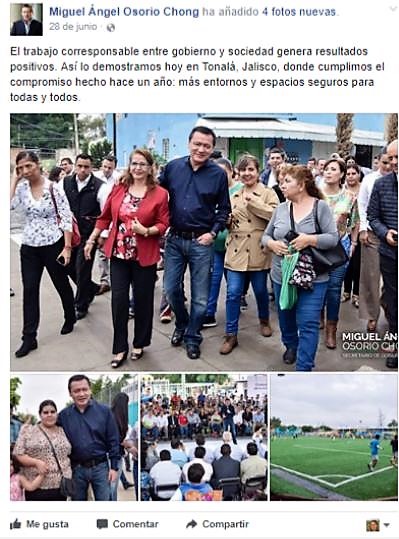
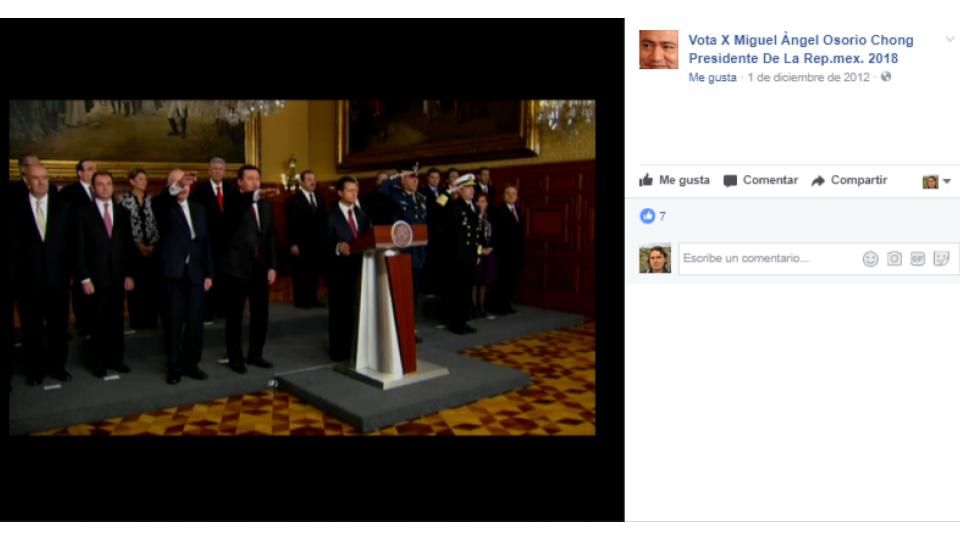
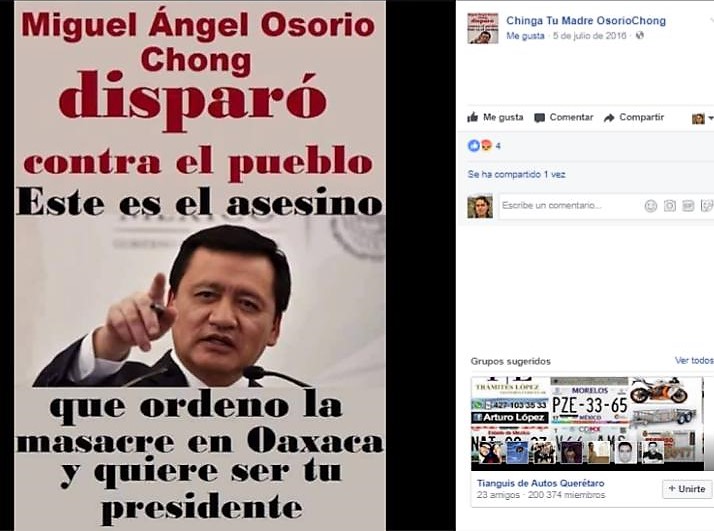
- A banner in his official Facebook fan-page (profile picture) with the message: “We create more opportunities to let the talent and people keep on going”.
- A photo from his unofficial praising page Nuevo León con el Bronco portraying him in front of a multitude with the message: “In Nuevo León we are achieving a whole revolution empowered by government and society”.
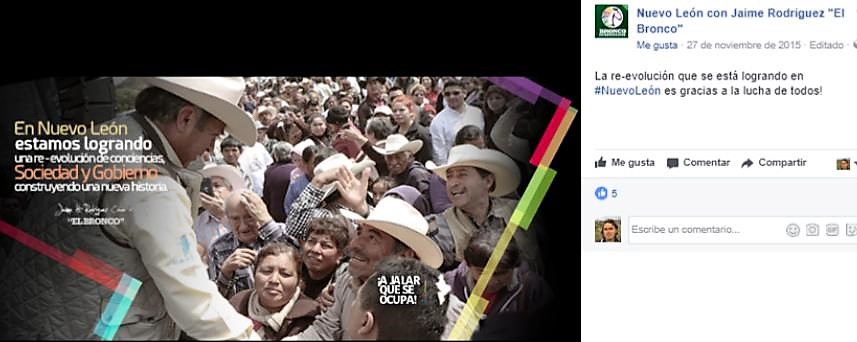

- Above all contents, the post with the highest engagement rate is Lopez Obrador´s last december family photo with a message to the ones who suffer in a religious and emancipatory tone with an average close to 7500 “likes”, “shares” and comments. Then, the second most relevant post is Mancera´s supportive message to gay community with an engagement rate around 6200. Both Margarita´s most popular posts (the “No to populism” message and the photo album of her visit to an open marketplace) are considerably below Mancera and López Obrador, both with an engagement rate near 2200. Miguel Ángel Osorio Chong and Jaime Rodríguez have no competitive posts; all their contents have an engagement rate below 1000, excepting one “praising” post of Osorio Chong (a photo album of one of his public events).
- Even López Obrador is the candidate with the highest rated post of all, he also has high rated revile and offensive posts against him. This shows he is the most popular candidate for certain communities and the most hated for others on Facebook, at the same time. The offensive post “AMLO is turning Mexico a Venezuela” has an engagement rate of 2200, while the post that say López Obrador is “incompetent” is over the rate of 1800.
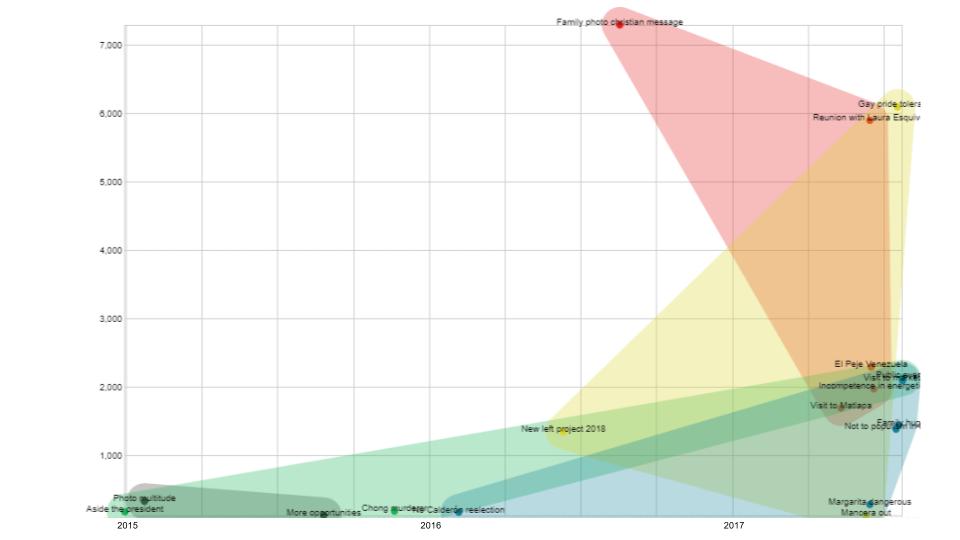
- Only López Obrador and Mancera have informative posts, but they cover a very small area, so they are not relevant in comparison to “praising” or offensive posts.
- López Obrador is still the candidate with the highest impact on Facebook, both in the “praising” and “revile” communities in pro or against him.
- Mancera, again, is in second place in the “praising” community.
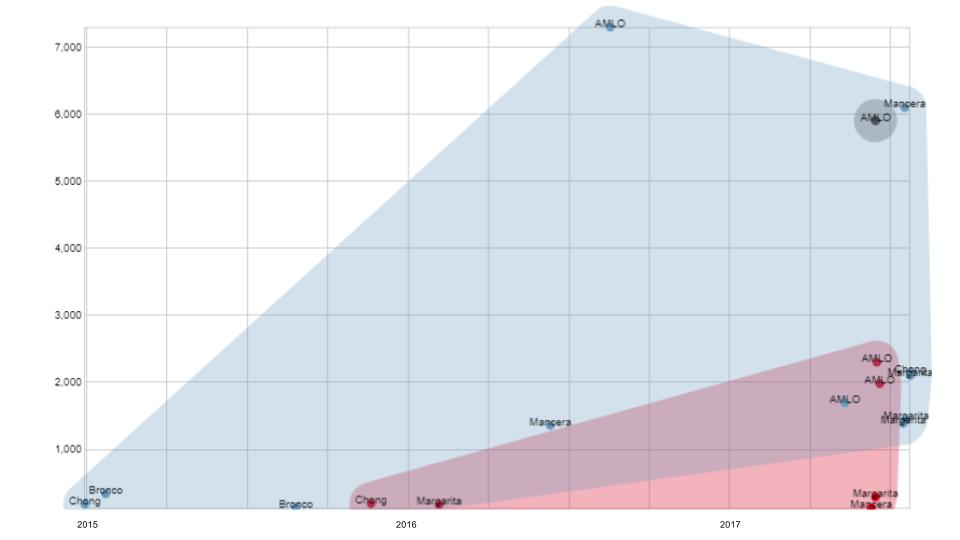
6. Discussion
6.1. Forecasting the aspirants of Mexican presidential elections 2018Although it is forbidden by the National Electoral Institute of Mexico (INE) to start making proselytism or support openly a political party or public figure as an aspirant to presidency before the electoral months (march to july, and 2018 in this case), there are 23 actual public servants, inactive politicians, journalists and activists that have declared their intention to run for the next elections. Not all of these aspirants have the same possibilities, because all of them come from different political and ideological backgrounds. Some used to be the governors of Mexican localities (Eruviel Ávila, Ivonne Ortega, Marcelo Ebrard); others, are governors or ministers still in the charge (Miguel Ángel Mancera, Jaime Rodríguez El Bronco, Luis Videgaray, Miguel Ángel Osorio Chong); and other ones, are syndical leaders (Gabriel Quadri), educators (José Narro), journalists (Ferriz de Con) or socialités (Carlos Slim) who only say they want to be president to open controversies and acquire public notoriety. From all cases, the ones with the most possibilities, according to the latest polls between the public opinion, are Margarita Zavala, ex-first lady, and Andrés Manuel López Obrador, main leftist candidate from the party Morena (Mitofsky, 2017). Maybe, the less popular of all candidates would be the ones of the PRI, because the role of this party in the actual administration has been so questioned and criticized by citizenship and media that the current president has the lowest levels of public acceptance in the last twenty years (Bloomberg News, 2017). Some of the incidents that caused this unpopularity were, among others: the disappearance of 43 college students in Ayotzinapa, Guerrero; the rising violence on public spaces; violations on human rights; censorship to the freedom of expression; the imprecise and redundant declarations of actual ministers on topics like corruption, insecurity or poverty; the steady increases in the prices of gasoline, oil products and energetics; and some cases of millionaire frauds from the governors of many localities (Moreno, 2016). If we consider as criteria their presence on Internet (total Google News results), other candidates with very few popularity are some enthusiasts that will run for presidency without the postulation of any party. These are called “independents” or “undefined” candidates, and all their web contents added together are not even close to the ones of the leading figures on Internet: López Obrador or Margarita Zavala. A candidate with more possibilities than these ones would be the moderate-left aspirant of the PRD and actual Mexico City mayor, Miguel Ángel Mancera; however, his rise or fall in public opinion and online media are still unclear and depend on his future decisions.
Among the situation of all candidates, the case of the main leftist aspirant, López Obrador from the party Morena, is special: he has run for the last two elections (2006 and 2012), and although he has been defeated, his popularity has grown considerably during the last twelve years. he has runned for the last two elections (2006 and 2012), and although he has been defeated, his popularity has grown considerably during the last twelve years. According to our study he is the leader of mentions in Google News with 202.2 million results. This is not coincidental. He has led the media contents since 2012, especially after declaring he had won legitimately the presidency and lost it only after an electoral fraud of the PRI's candidate, Enrique Peña Nieto. Today, it can be said that those responsible of López Obrador´s public image and communications are the most active in both traditional press and social media. The difference of total results in Google News between López Obrador and the most popular candidate after him, Ricardo Anaya from the PAN, is near 8 million URLs. This does not mean automatically that López Obrador will be the next president of Mexico. In the total of Google News are lots of negative results about López Obrador, and also some media contrast in the same content the image of Obrador negatively, supporting another candidate. What it can be definitively said is that López Obrador is the candidate the people and media are talking the most about on Internet, for either positive or negative purposes.
6.2. Contrast between Google News results and total Facebook pagesThe total results of a candidate on Google News do not determine necessarily his popularity on Facebook. Some aspirants like Andrés Manuel López Obrador or, in a lower proportion, Margarita Zavala, are both popular on Internet media and Facebook, but other candidates that have acquired relevance online like Rafael Moreno Valle, Ricardo Anaya, Luis Videgaray, Marcelo Ebrard or Jorge Castañeda have no pages on Facebook related to them, excepting his own official fan-page. López Obrador is the current aspirant with more results online and active Facebook pages with his name or associated to some of his short names or nicknames (AMLO, El Peje). This is understandable, because some of this pages (his official fan-page and Movimiento Morena AMLO, for example) have been opened since 2010, while the vast majority come from the election of 2012. López Obrador is the only candidate that has run for three electoral processes, so his presence on Facebook has been longer-lasting. The difference in the number of Facebook pages between López Obrador and other possible contenders is not superficial: there is a margin of almost 50 pages from López Obrador to Margarita Zavala, and 66 pages from Morena candidate to the least popular aspirant considered, Jaime Rodríguez El Bronco. On the other side, the difference between all candidates below López Obrador and Margarita Zavala is not relevant: the margin between Miguel Ángel Mancera, Miguel Ángel Osorio Chong and Jaime Rodríguez is 2 pages per each one. In all cases it is very important to consider that the most popular candidates are not the most supported. Some Facebook pages are created to offend a candidate, report his mistakes or “troll” him and his supporters. This is why we did not only consider the total Facebook pages, but also the type, tendency and function of each page.
Total Facebook pages is a significant standard, but the total of “likes” or “following” in those pages is also essential. A candidate may have lots of pages with very few followers in each one, so to consider an aspirant as the most popular he must have both a high number of pages and a large audience. On this study López Obrador is the most “followed” candidate of all, while Margarita Zavala, even having 24 pages, is very close in followers to Miguel Ángel Mancera, who is around 100 thousand followers below. Osorio Chong is far below Zavala and Mancera with 700 thousand followers less, and Jaime Rodríguez is definitively the least popular candidate, with a difference of almost 1 million followers from López Obrador. Our tentative explanations of these phenomena are:- López Obrador is ideologically the most polemical candidate, while he has been, as we said before, running for the presidency for a longer time. He has more presence on media and his name, declarations and slogans are more active on public opinion.
- Margarita Zavala is well-known too, but more linked to her couple, ex-president Felipe Calderón, rather than by herself. Her considerable number of followers can be associated to her large citizen and conservative organization, Yo con México, and to the supporters (or haters) of her husband.
- Miguel Ángel Mancera has a high number of followers because he is the mayor of Mexico´s larger city: its capital. Many of his followers, probably, are not only supporters or detractors, but also citizens interested in his actual government.
- Miguel Ángel Osorio Chong is popular among the followers of the PRI, but very unpopular between the citizenship in general, who are not interested in following him at all, or consider him incompetent as Federal Minister of government due to the latest violence and inequality in the current administration.
- Finally, Jaime Rodríguez Calderón has a low number of followers because he is only popular in his locality, Nuevo León, but remains unknown to the rest of the country.
As we commented before, the number of official and unofficial pages is as important as the number of followers distributed on them. In all cases, the official followers are considerably higher than unofficial ones (52.7% in López Obrador, 92% in Margarita, 99.9% in Mancera, 99.5% in Chong and 97.1% in Jaime Rodríguez). This may show people prefer to follow an official political page on Facebook rather than an unofficial. Maybe, the contents in official pages are more reliable, actual and diverse. Also, official pages are too much more widespread by the Facebook platform´s algorithm among all users. When a page has clear metadata, contents and links, Facebook has more information to find possible “likers” or followers of the page, suggesting it to communities of users (or clusters of Facebook IDs). Facebook unofficial pages are mostly opened just to reach close friends or impact a small community, while official pages tend to viralize and be more interlinked between each other. Besides, the difference in followers in official and unofficial pages can be explained due to the hiring of the Facebook services for public contents. Some pages, like the candidates´ official accounts on Facebook, do not only acquire followers traditionally, by spreading slowly from one profile to another, but by the strategic distribution provided by the Facebook headquarters in exchange for a previous payment. Facebook offers marketing plans to reach the largest amount of followers and the most engaged people, using data matching techniques (popular keywords, photos or links). Also, Facebook offers datasets of “likers” or followers for each page manager, a default number of followers (taken all from outdated and closed pages), or special announcements (for example, “lots of your friends like this candidate”) as paid services.
- López Obrador´s supporters of his main “informative” and “praising” pages, Red Nacional de Jóvenes por AMLO and Radio AMLO are public and international left intellectuals like Noam Chomsky or the French politician Jean Luc Melenchon, web left newspapers like Revolución 3.0 and Regeneración, Mexican politicians of Morena (the party of López Obrador) like Alejandro Encinas, and international left movements like the Spanish Podemos or La Mano Sucia de Chevron, a collective denouncing the abuses of global oil companies. Other important supporters are Mexican journalists like Carmen Aristegui or John Ackerman, who have not openly defined themselves as leftist, but have standed their opposition to the PRI and Peña Nieto. On the other side, the main haters of this candidate are neoliberal movements (No al fanatismo de izquierda) and people that use humour to praise the PRI and the conservative and liberal heritage (using as symbol, the ex-president Carlos Salinas de Gortari, defender of free trade and the North American Trade Agreement).
- In the case of Margarita Zavala, her supporters are mainly women committees from the PAN, sympathizers of the association Yo con México or private and international universities´ students associations. Her opposers are, in several terms, the supporters of Obrador: leftist Internet media, left thinkers and journalists and collectives or activists.
- Miguel Ángel Mancera´s supporters are museums and public institutions from Mexico city, maybe because of his actual role as mayor of this locality. His haters, on the other side, are collectives that oppose to his administration, like Los Civercívicos.
- Miguel Ángel Osorio Chong´s supporters are people who work or sympathize with the PRI, while his opposers are people from the progressive left associated with López Obrador.
- Finally, Jaime Rodríguez Calderón supporters are marketplaces, governmental institutions and companies from Nuevo León, the locality where he govern. He has no opposers on Facebook.
There is a close correspondence between the profile of followers of each candidate according to their pages´ tendencies and functions, and their most engaging posts. López Obrador´s most relevant “praising” posts are photos that portray him as a decent and kind man, concerned in the improvement of Mexican citizens. In one of his photos, he appears with all his family as a lovable father and refers to justice and christianity to promise a political change in 2018. In another photo, he appears surrounded by poor people, showing sensitive and protective. The tone of these posts is completely opposite than the most engaging offensive posts of López Obrador: a photo comparing him with Hugo Chávez and a video showing the inconsistencies of his discourse. In the case of Margarita Zavala, the most engaging posts in pro of her portray her as a mother concerned about family values and a fighter against populism, while the highest rated posts against her show her and Felipe Calderón as assassins. The most engaging post of Miguel Ángel Mancera is related to gay pride agenda. He is the only candidate related with this topic. His most relevant offensive post, on the other hand, shows his incompetence as mayor. Miguel Ángel Osorio Chong is radically portrayed as a committed statesman or a murderer, and Jaime Rodríguez El Bronco, as a popular governor, dressed as a cowboy, close to poor people. All these posts are full of radicalism, emotionalism and exaggeration. We may consider Facebook's most engaging contents are more visual than written or auditive, and that in the background of a presidential election, posts are more related to irrational sympathy or hate rather than deep or critical analysis.
7. Conclusion
This project was only an exploratory overview of how the actual Mexican presidential pre-campaigns have used Facebook pages as a tool to promote or denigrate the image of a certain candidate. It is too soon to determine who will be the aspirant with a larger number of supporters or detractors in 2018, but we found the advantage of López Obrador in total amount of pages and organized sympathizers is so considerable that it is hard to find another candidate as polemical and recurrent as him. Nevertheless, López Obrador has a lot of haters on Facebook, and even their presence is not as significant as his supporters, their influence can still grow on the following months. On the other side, Margarita Zavala has emerged as the strongest contender of López Obrador. Her supporters and praising pages are growing everyday on Facebook, but her total amount of fans is still considerably smaller than López Obrador´s followers. However, the people supporting Zavala are well defined and organized, mainly by her citizen association Yo con México. Miguel Ángel Mancera is a popular candidate among Mexico city, but he still lacks of relevance outside the capital. Maybe, if we take out from his supporters all institutions, companies and organizations related to his actual role as mayor and evaluate his true sympathizers, we would find he has not a relevant amount of followers to consider him as a possible winner of future elections. The other candidates, Miguel Ángel Osorio Chong and Jaime Rodríguez, are not substantial to the course of future elections. Their supporters and detractors are very few in comparison to López Obrador´s and Zavala´s, and they lack of Facebook pages and engaging contents to be considered as important electoral figures. During last elections, in 2006 and 2012, all candidates stopped focusing on each other and unified in an offensive and fearful discourse against López Obrador. It is very possible that on next 2018 elections we will find a similar scenario, but the facts can still change considering the future role of traditional and digital media, the fluctuation on the tendencies of the public opinion, the speech of each candidate during the next year, and also the commitment and activity of Facebook pages.
8. References
Belin, A. (2015). Hora libre. Yunes y Duarte: Igual discurso ante el crimen. Palabras claras. https://palabrasclaras.mx/los-que-opinan/yunes-y-duarte-igual-discurso-ante-el-crimen/ Retrieved july 31 2017. Bloomberg News. (2017). El impopular PRI lucha por mantener el poder. El Financiero. http://www.elfinanciero.com.mx/nacional/el-pri-lucha-por-retener-el-poder.html. Retrieved august 7 2017. Covarrubias, A. (2012). Elecciones 2012-Presidencial. Observatorio mexicano de encuestas sociales. http://www.opinamexico.org/Elecciones-2012---Presidencial---Covarrubias-y-Asociados-23-04-2012-2012-04-24.html Retrieved july 31 2017. Fernández Santillán, J. (2017). Transgresiones a la democracia: Los nuevos populismos. Este País. http://www.estepais.com/articulo.php?id=873&t=transgresiones-a-la-democracia-el-avance-del-populismo- Retrieved august 7 2017.Mitofsky Consultant Group (2017). Las preferencias rumbo a la presidencia de 2018. Mitofsky. http://www.consulta.mx/index.php/estudios-e-investigaciones/elecciones-mexico/item/869-preferencias-rumbo-2018 Retrieved august 7 2017.
Moreno, M. (2016). El “derrumbe”: un balance del sexenio de Enrique Peña Nieto. Aristegui Noticias. http://aristeguinoticias.com/2410/lomasdestacado/el-derrumbe-un-balance-del-sexenio-de-pena-nieto-por-martin-moreno/ Retrieved august 7 2017. Moretti, F. (2013). Distant Reading. California: Verso. Pedraza, H. (2006). Evaluación del proceso electoral 2006: El testimonio de un consejero distrital del IFE (Instituto Federal Electoral). Nóesis. http://www.redalyc.org/html/859/85903112/ Retrieved july 31 2017. Poy, L. (2012). #Yosoy132 presenta mil 100 casos de irregularidades y delitos electorales. La Jornada. http://www.jornada.unam.mx/2012/07/06/index.php?section=politica&article=016n1pol Retrieved july 31 2017. Resultados de las elecciones de Estado de México 2017. Milenio Digital. http://www.milenio.com/politica/elecciones-estado-mexico/resultados-elecciones_edomex-2017-ganador-prep-nuevo_gobernador-milenio_0_968903293.html Retrieved july 31 2017. Rieder, B. (2013). Studying Facebook via data extraction: the Netvizz application. Web Sci '13 Proceedings of the 5th Annual ACM Web Science Conference, pp. 346-355. New York: ACM. Rouse, M. (2017). What is a Facebook Page? TechTarget. http://whatis.techtarget.com/definition/Facebook-page Retrieved july 31 2017. Copyright © by the contributing authors. All material on this collaboration platform is the property of the contributing authors.
Copyright © by the contributing authors. All material on this collaboration platform is the property of the contributing authors. Ideas, requests, problems regarding Foswiki? Send feedback
